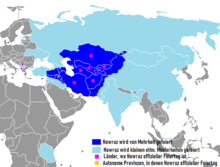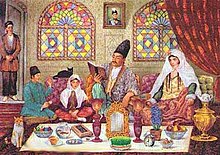Nowruz
![]()
Nowruz is a redirect to this article. See also: Nowruz (magazine).
Nouruz (Persian نوروز, DMG Naurūz, Kurdish نهورۆز Newroz, Turkish Nevruz; translated "New Day") is the name of the New Year and spring festival, which is celebrated especially in the Persian cultural area with the beginning of spring (equinox), the day of the astronomically calculated entry of the sun into the zodiac sign of Aries. The day falls on March 20 or 21 and its beginning at different times according to the beginning of the equinox.
Since 10 May 2010, Nouruz has been recognized as "International Nouruz Day" by decision of the 64th General Assembly of the United Nations. The General Assembly stated in its declaration that "Nouruz is a spring festival celebrated by more than 300 million people for more than 3000 years in the Balkan Peninsula, the Black Sea region, the Caucasus, Central Asia and the Middle East". On September 30, 2009, UNESCO included Nouruz Day in the list of Masterpieces of the Oral and Intangible Heritage of Humanity.

Countries where Nouruz is celebrated
Etymology
Literally translated, Nouruz means "new day" (nou or nau, "new"; ruz, "day"). The words روز rūz, رۆچ roç or رۆژ roj in Iranian languages, which stand for day, go back to the Ur-Indo-European Rauça (pronounced "Rautscha"), which in turn comes from the Ur-Indo-European *Leuk-, which also gave rise to the word "light" in German. In Iranian languages, there was a sound shift from "l" to "r" and from /k/ to /č/.
In Old Iranian Avestic, Raôçah was actually used for light, new was navā. The Old Persian form was Rauçah. In Old Indo-Aryan, Roçiş (pronounced Rauçah) was in use.
The current term Nou-Roz was first mentioned in the 2nd century.
.jpg)
The fight between the bull (symbol for the earth) and the lion (symbol for the sun) as a symbol of the Zoroastrian Nouruz, Persepolis, Iran
History
Until the 1st century BC, the summer solstice marked the turn of the year in the Iranian highlands, which was celebrated with great harvest festivals. Under the Achaemenids (6th-4th century BC), the vernal equinox became the official start of the year. Among the Iranian peoples of Iran, Tajikistan, and Afghanistan, this date is calculated to the hour and minute by astronomers to this day. On this day, the Kharaj tax was levied. The tradition of the New Year has survived to this day and has spread to East Africa.
One of the best-known versions of the origin of the New Year's festival was recorded by the Persian poet Firdausi (c. 940 to 1020/1026) in his Shāhnāme ("King's Book"). Firdausi places the institution of the New Year festival of Nouruz in the reign of Jamshid. Jamshid was the fourth king from the mythical ruling dynasty of the Kayanids. He ruled over all beasts, demons and angels. He was both king and chief priest of Ormozd (Middle Persian for Ahura Mazda). Firdausi writes about Jamshid:
"There sat, like the shining sun on the air,
The Shah, who revokes no commandment.
Jewels to him scattering they stood,The
day New Year's Day they called.
Year's beginning, Hormus of the FerwedinWas,
when the joy of the world appeared.
...
From those days such a joyous dayBelonged to
us from that prince."
Among the Parsis in India, therefore, this day is still called Jamshēd-i Nawrōz. In Persia, the day was the most important secular holiday over the centuries, but it was also considered a public holiday in the Kurdish provinces of the Ottoman Empire. It was celebrated as a great folk festival, with equestrian games and people gathering in squares and streets, lighting fires and splashing each other with water. In Achaemenid times, on Nouruz the people were not liable to pay taxes for a certain period of time. But the day was also important for quite different reasons. For on Nouruz representatives of the subjugated peoples came to Persia and brought gifts to the Persian king.
After the fall of the pre-Islamic Sassanid Empire in the mid-7th century and the subsequent Islamization of Persia, Nouruz was celebrated on different days. Initially, Nouruz was on June 18. The caliph al-Mutawakkil moved the day to the 17th and al-Mu'tadid to the 11th of June. In a calendar reform under the Seljuk ruler Malik Shah I, Nouruz was fixed on March 15 in 1079. Today Nouruz is celebrated on March 20 or 21.
In Iran and among the Kurds, its character as a rite of passage has been preserved to this day. In preparation for the new phase of life, new clothes are put on and, as a sign of the end of winter, bonfires are lit over which people jump and around which especially the boys dance and sing. The women prepare a feast and together relatives and friends go to a park or outing. Sometimes a band is engaged, usually the musicians move from one gathering to the next, playing traditional, political or love songs according to taste.
With the spread of nationalist ideas in the 20th century, the festival acquired greater political significance among the Kurds. They celebrate the New Year on 21 March as a symbol of the successful resistance against oppression handed down in Iranian mythology. At the centre of this tradition are the legends of the tyrant Zohak (Dahak, Dahaq), who was presented as a child-eating dragon king, and his conqueror, the blacksmith Kaveh. Together with the people, Kaveh went out and slew Zohak. Out of joy, the people lit a fire that spread the news throughout the land. According to tradition, this took place on March 21 in the year 612 BC. Historically, this year corresponds with the victory of the Medes over the Assyrians at Nineveh. In another common form, the legend is expanded to the myth of origin.
In the Bahai calendar, Nouruz (Naw-Ruz) is one of nine holidays, marking the beginning of the new year and the end of the nineteen-day Bahai fasting period.
Since the last century, Nouruz has spread widely across Iran, Turkey, Iraq, Syria and Central Asia. In addition, today people celebrate Nouruz in Russia and the Balkans. Each country has its specific spelling and pronunciation of the term "Nouruz".

Nouruz in Iran
Search within the encyclopedia